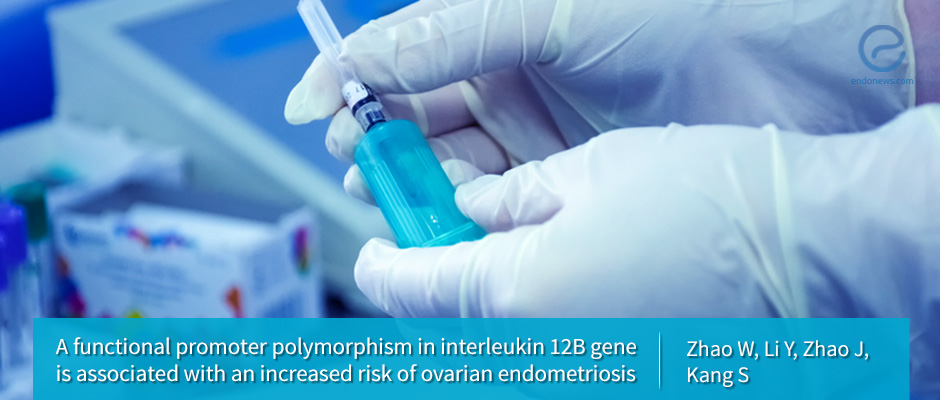Polymorphism of IL12B May Help Solve Endometriosis
Jul 24, 2018
Two polymorphisms of the gene IL12B were thought to perhaps play a role in Endometriosis disease progression, but only one was confirmed to play a role in the development of the ailment.
Key Points
Highlights:
- This study aims to better understand the function of two genetic variants of the IL12B gene and to elucidate the role of these polymorphisms in ovarian endometriosis.
Importance
- The Sampson theory as one of the most widely accepted theories explaining the pathogenesis of endometriosis; however, t does not answer the following questions related to disease:
- When a majority of women undergo retrograde menstruation, how come only a small subset of those women actually develop endometriosis?
- How can one explain the presence of endometriosis at other sites?
- Accordingly, the researchers need to find other reasons for the development of the diseases. Identifying these factors will allow for more targeted therapies and treatments.
What’s done here?
- Participants were composed of the case group (815 women with histologically confirmed ovarian endometriosis) and the control group (788 women without ovarian endometriosis)
- Biomaterial collection performed from eutopic endometrial tissues from 45 participants with ovarian endometriosis and 5 mL of venous blood from each subject.
- The IL12B polymorphism genotyping utilized the polymerase chain reaction/ligase detection reaction (PCR-LDR) method and an ABI 3730XL DNA sequencer was used for product analysis.
- IL12B mRNA expression levels were analyzed using quantitative real-time polymerase chain reaction (qRT-PCR) where IL-12B expression was calculated with respect to GAPDH expression.
- The data was subject to statistical analysis.
Key results:
- rs17860508 was found to have 2 genotypes, namely GC/GC and GC/CTCTAA, that when compared to CTCTAA/CTCTAA was found to increase the risk of developing ovarian endometriosis.
- Participants with the genotype of GC/GC also had higher expression levels of IL12B mRNA in their eutopic endometrial tissue. This was when the GC/GC genotype participants were compared to the CTCTAA/CTCTAA genotype.
- The results led the authors to believe that the functional genetic variant classified as rs3212227 may not be tied with ovarian endometriosis risk.
Limitations of the study:
- The authors noted 2 limitations in their study:
- The researchers did not use immunohistochemistry to analyze the IL12p40 protein expression level and cellular localization in the endometrial tissue.
- There may be selection bias and systematic error.
Lay Summary
Zhao et al. recently published a paper titled “A functional promoter polymorphism in interleukin 12B gene is associated with an increased risk of ovarian endometriosis” in Gene. The research group from Hebei Medical University wanted to explore the potential roles played by the polymorphisms rs17860508 CTCTAA/GC and rs3212227A/C, functional genetic variants of the interleukin 12beta gene (IL12beta), in the development of ovarian endometriosis.
The case-control study consisted of two participant groups: one group of women with ovarian endometriosis and another group of women without ovarian endometriosis. The researchers collected eutopic endometrium tissues from 45 women with ovarian endometriosis. This tissue underwent total RNA isolation and cDNA synthesis. Venous blood samples were collected from all the participants and the genomic DNA was extracted from those samples. The polymerase chain reaction/ligase detection reaction (PCR-LDR) method was used to genotype the two IL12beta polymorphisms. IL12beta mRNA expression levels were measured using quantitative real-time polymerase chain reaction (qRT-PCR). The data was subject to statistical analysis.
The rs3212227 polymorphism was not found to be linked to an increased risk of ovarian endometriosis; however, there were a couple genotypes of rs17860508, namely the GC/GC and GC/CTCTAA, that when compared to the CTCTAA/CTCTAA genotype, were associated with an increased risk of developing ovarian endometriosis. The researchers also found that participants with the GC/GC genotype had higher levels of IL12beta mRNA expression in the eutopic endometrial tissue compared to the participants who had the CTCTAA/CTCTAA genotype.
In conclusion, the researchers found that the rs17860508 polymorphism may, in fact, play a role in ovarian endometriosis development. Its function could also rely on abnormal IL12beta expression.
Research Source: https://www.ncbi.nlm.nih.gov/pubmed/29738836
polymorphism interleukin 12B gene genetics ovarian endometriosis PCR mRNA DNA protein

